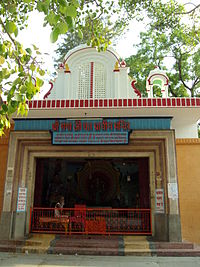Daksheswar Mahadev Temple
| Daksheswar Mahadev Temple | |
|---|---|
| Religion | |
| Affiliation | Hinduism |
| District | Haridwar |
| Deity | Daksheswar Mahadev (Shiva) |
| Festivals | Maha Shivaratri, Navratri |
| Location | |
| Location | Kankhal |
| State | Uttarakhand |
| Country | India |
| Geographic coordinates | 29°55′18.72″N 78°08′45.04″E / 29.9218667°N 78.1458444°ECoordinates: 29°55′18.72″N 78°08′45.04″E / 29.9218667°N 78.1458444°E |
| Architecture | |
| Type | Nagara style |
| Creator | Queen Dhankaur |
| Completed | 1810 CE |
Daksheswar Mahadev (Hindi: दक्षेश्वर महादेव मन्दिर) or Daksha Mahadev temple is a Hindu temple dedicated to Lord Shiva, located in the town of Kankhal, about 4 km from Haridwar, Uttarakhand, India. It is named after King Daksha Prajapati, the father of Sati.[1] Daksha is one of the fourteen Prajapatis, creator deities, who preside over procreation and are the protector of life in Hindu mythology.
The present temple was built by Queen Dhankaur in 1810 and rebuilt in 1962. It is a place of pilgrimage for Shaivaite devotees on Maha Shivaratri.[2]
The legend of Daksha[edit]
As mentioned in the Mahabharata and other texts of Hinduism, King Daksha Prajapati, the father of Sati, Shiva's first wife, performed yajna at the place where the temple is situated. Although Sati felt insulted when her father did not invite Shiva to the ritual, she attended the yajna. She found that Shiva was being spurned by her father and she burnt herself in the Yajna Kunda itself. Shiva got angry and sent his Gaṇas, the terrible demi-god Virabhadra and Bhadrakali to the ritual.[3] On the direction of Shiva, Virabhadra appeared with Shiva's ganas in the midst of Daksha's assembly like a storm wind and waged a fierce war with the gods and mortals present culminating in the beheading of Daksha, who was later given the head of a goat at the behest of Brahma and other gods. Much of the details of the Ashvamedha Yagna (Horse Sacrifice) of Daksha are found in the Vayu Purana.
Other structures[edit]
Standing next to the main temple is the Das Mahavidya temple, dedicated to the Mahavidyas. It is a venue for devotees of Devi to congregate for special pujas during the Navratri celebrations. There is also a temple in the complex dedicated to Ganga. Next to the temple is the Daksha Ghat on the Ganges and close by is the Nileshwar Mahadev Temple.
References[edit]
- ↑ The Story of Daksh. Sati, the consort of Shiva was the daughter of Daksha...
- ↑ Daksheswar Mahadev Temple
- ↑ the Horse-sacrifice of the Prajapati Daksha The Mahabharata translated by Kisari Mohan Ganguli (1883 -1896], Book 12: Santi Parva: Mokshadharma Parva: Section CCLXXXIV. p. 317. "I am known by the name of Virabhadra’’ and I have sprung from the wrath of Rudra. This lady (who is my companion) is called Bhadrakali and hath sprung from the wrath of the goddess."


